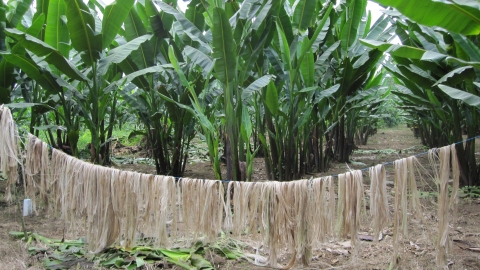Musa textilis
Née
Musaceae
Musa abaca Perr.
Musa amboinensis Miq.
Musa mindanaensis Miq.
Musa tikap Warb.
Musa troglodytarum textoria Blanco
Common Name: Abaca

The fibre drying amongst a plantation of the plants
Photograph by: John Washington
GNU Free Documentation License
General Information
Musa textilis is a tall, herbaceous, evergreen perennial plant growing up to 6 metres tall with leaves that can be 2 metres long and 60cm wide[
200- Title
- The New RHS Dictionary of Gardening. 1992.
- Publication
-
- Author
- Huxley. A.
- Publisher
- MacMillan Press
- Year
- 1992
- ISBN
- 0-333-47494-5
- Description
- Excellent and very comprehensive, though it contains a number of silly mistakes. Readable yet also very detailed.
]. The plant produces a clump of large pseudostems up to 30cm in diameter at the base, that make it appear rather tree-like. These stems grow up from a perennial stoloniferous rootstock[
200- Title
- The New RHS Dictionary of Gardening. 1992.
- Publication
-
- Author
- Huxley. A.
- Publisher
- MacMillan Press
- Year
- 1992
- ISBN
- 0-333-47494-5
- Description
- Excellent and very comprehensive, though it contains a number of silly mistakes. Readable yet also very detailed.
].
Abaca is one of the most important fibre plants in the world, and it is cultivated for its fibre on a large scale in the Philippines, and to a much lesser extent in Sumatra, Ecuador and Central America[
]. Total production, however, has dropped considerably since the introduction of synthetic fibres.
Known Hazards
None known
Botanical References
200- Title
- The New RHS Dictionary of Gardening. 1992.
- Publication
-
- Author
- Huxley. A.
- Publisher
- MacMillan Press
- Year
- 1992
- ISBN
- 0-333-47494-5
- Description
- Excellent and very comprehensive, though it contains a number of silly mistakes. Readable yet also very detailed.
Range
Southeast Asia - Philippines.
Habitat
Not known
Properties
| Other Uses Rating |      |
| Habit | Evergreen Perennial |
| Height | 6.00 m |
| Cultivation Status | Cultivated |
Cultivation Details
A plant of the hot, humid tropics adapted to an average relative humidity of about 80%[
]. The present zone of successful cultivation lies within the latitudinal range 15°N and 5°S. In the Philippines it is usually grown in regions below 500 metres in elevations but it can be grown in the tropics at altitudes between sea level and 1100 metres[
]. It grows best in areas where the mean annual temperature falls within the range 20 - 29°c, but can tolerate 16 - 33°c[
]. It prefers a mean annual rainfall in the range 1,800 - 3,000mm, tolerating 700 - 4,400mm[
].
Prefers a sunny position[
]. Plants can succeed in most humus-rich, fertile soils, so long as they are well-drained[
]. Prefers a pH in the range 5.5 - 7, though it can tolerate 4.5 - 8[
]. Prefers a position sheltered from strong winds.
A perennial plant, growing for 18 - 36 months years before first harvest and with a economical life of 6 - 15 years[
].
In the Philippines, the annual fibre yield ranges from 0.31 - 1.71 t/ha, while in Ecuador, yields are between 1.5 - 2.5 t/ha[
].
Edible Uses
None known
Medicinal
None known
Other Uses
The sclerenchym fibres of the leaf sheaths are used to make ropes for ships and nets that are resistant to salt-water[
]. The fibre is also used to make sacks, cloth etc[
46- Title
- Dictionary of Economic Plants.
- Publication
-
- Author
- Uphof. J. C. Th.
- Publisher
- Weinheim
- Year
- 1959
- ISBN
- -
- Description
- An excellent and very comprehensive guide but it only gives very short descriptions of the uses without any details of how to utilize the plants. Not for the casual reader.
,
]. In Japan it is used for making special paper for the construction of movable room walls[
]. With the advent of synthetic fibres, demand for this plant has been reducing, though it is becoming increasingly popular as a source of fibre for pulp[
].
Propagation
Seed -
Division of suckers with a portion of the rhizome[
200- Title
- The New RHS Dictionary of Gardening. 1992.
- Publication
-
- Author
- Huxley. A.
- Publisher
- MacMillan Press
- Year
- 1992
- ISBN
- 0-333-47494-5
- Description
- Excellent and very comprehensive, though it contains a number of silly mistakes. Readable yet also very detailed.
].
If you have any useful information about this plant, please leave a comment. Comments have to be approved before they are shown here.






 Useful Tropical Plants Database 2014 by
Ken Fern,
web interface by
Ajna Fern
with help from
Richard Morris.
Useful Tropical Plants Database 2014 by
Ken Fern,
web interface by
Ajna Fern
with help from
Richard Morris.